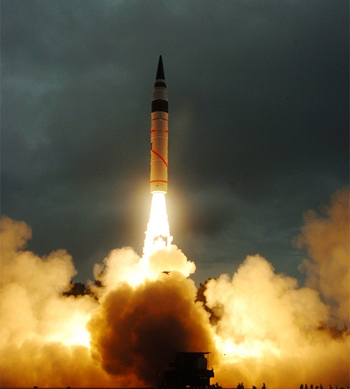INDIAN ARMED FORCES CHIEFS ON
OUR RELENTLESS AND FOCUSED PUBLISHING EFFORTS

SP Guide Publications puts forth a well compiled articulation of issues, pursuits and accomplishments of the Indian Army, over the years

I am confident that SP Guide Publications would continue to inform, inspire and influence.

My compliments to SP Guide Publications for informative and credible reportage on contemporary aerospace issues over the past six decades.
- Prime Minister witnesses 'Bharat Shakti' – a Tri-Services Firing and Manoeuvre Exercise in Pokhran, Rajasthan
- Interim Defence Budget 2024-25 — An Analysis
- Union Defence budget 2024
- Indian Army: In quest of greater firepower and policy recommendations for gaps
- Indian Army Annual Press Conference 2024
- 6G will transform military-industrial applications
India test fires nuclear capable ICBM Agni-5
Giving major boost to India's nuclear launch capability, Agni-5, after its fifth successful test, is now ready for induction.

India on January 18 successfully tested its nuclear capable Intercontinental ballistic missile Agni-5 from a canister on a road mobile launcher. This is the fifth consecutive successful test of the missile and third from a canister.
The three stage nuclear capable missile was tested for its full range at around 10 a.m. from Dr Abdul Kalam Island, Odisha. Most of the Eurasian land mass falls within its 5,000 km range.
"The flight performance of the missile was tracked and monitored by radars, range stations and tracking systems all through the mission. All objectives of the mission have been successfully met. This successful test of Agni-5 reaffirms the country's indigenous missile capabilities and further strengthens our credible deterrence," Ministry of Defence said in a statement.
Lauding the Defence Research and Development Organisation (DRDO) and Indian industry for the success, Minister of Defence Nirmala Sitharaman in a tweet said, "A major boost to the defence capabilities of our country."
Congratulating the Agni-5 team, S Christopher, Chairman DRDO, said that the fifth consecutive successful flight test of Agni-5 is a major boost to country's defence capabilities.
With this test, Agni-5 has achieved validation and is ready for mass production and inclusion in Indian arsenal.
First tested on April 19, 2012, Agni-5, in addition to launching nuclear weapons, is also capable of launching battle field satellites which can provide real time information of the battle field from the lower earth orbit.
The three propulsion stages and the Composite Rocket Motors are indigenously developed by DRDO and signify India's complete self-reliance in this complex propulsion technology.
It has number of indigenous technologies like the redundant Navigation systems, very high accuracy Ring Laser Gyro based Inertial Navigation System (RINS) and accurate Micro Navigation System (MINS) which allows the Missile to reach the target point within few meters of accuracy. For a long range ballistic missile this is very high level of accuracy and it gives it the capability to hit well protected deeply buried nuclear missile silos.
The launch was witnessed by Scientific Adviser to Raksha Mantri and Director General, Missiles and Strategic Systems Dr G Satheesh Reddy, senior DRDO scientists and senior officials from the Armed Forces.
After the first test, it was again tested in 2013, 2015 and 2016. The first two tests of the missile were not from the canister. Third test was the first test of the canisterised missile – which will give the flexibility of mating the missile with the nuclear warhead and keep it ready for launch.
India employs both road and rail missile launchers for its Agni series of missiles.
Agni-5 in future is expected to have Multiple Independently Targetable Reentry Vehicle (MIRVs). It can then carry 2-10 warheads in each missile with different targets to hit.





